Choosing A Weaving Loom
Choosing which weaving loom to buy can by a daunting process. At Weft Blown we supply a wide range of looms from a starters weaving kit up to 8 shaft floor looms and we want to make deciding what suits your needs easier for you so we have created this guide to help explain the differences between each type of loom we sell and what you can make with them.
Before we start there are a two technical words that may help you if you are completely new to weaving:
Warp - The yarn that is measured and wound onto the loom.
Weft - The yarn that is added by a shuttle or by hand between the warp yarn on the loom.
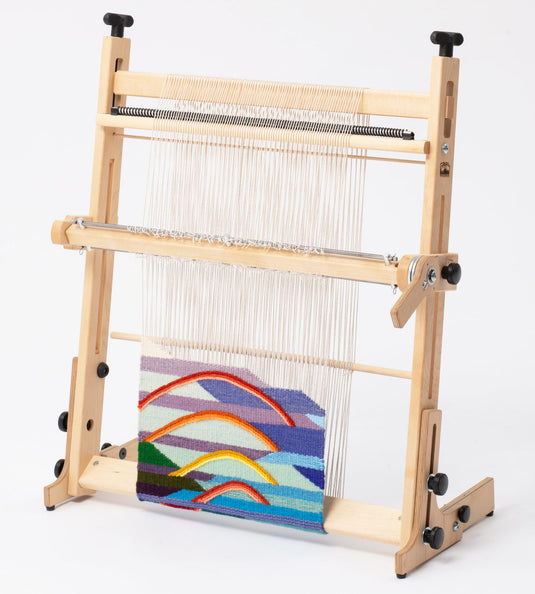
Tapestry Looms
Suitable for Beginner to Intermediate Weavers
Tapestry Looms, such as the Ashford Frame Loom or Schacht School Loom, are simple looms that you can do anything from basic weaving to complex textile tapestry art on them. The warp threads are simply wound around indentations or teeth on the loom at a regular spacing and you can use simple cotton string for the warp.
You can then add the weft which can be anything from yarn, fibre, material to even driftwood or shells. To add in the weft you can use tapestry bobbins, a stick shuttle or even just your hands. You can also use a tapestry beater to pack down your weft too.
For ideas on what you can weave check out Tapestry Weaving by Kirsten Glasbrook or DIY Woven Art by Rachel Denbow books.
Tapestry looms are very versatile looms and come in a range of sizes and are great for beginners to learn the basics of weaving.
Pin Looms
Suitable for Beginner Weavers
Pin Looms such as the Schacht Zoom Loom, Turtle Looms and Hazel Rose Pin Looms are the ideal introduction to weaving as they are very simple to use and you can create a handwoven square, hexagon, heart, triangle or diamond in less than an hour.
To weave you first wind the yarn around the pins following the instructions included and then for the final round you weave over and under with the needle that comes with the loom.
These looms are great for using up those odds and ends of yarn that you have left over from other projects.
You can join up your handwoven shapes by sewing them together, or using crochet or knitting to piece them together too. You can also embellish them using embroidery or needle felting. You can join them together to make anything from a placemat to a blanket and even a coat. For ideas have a look at our Pin Loom Inspiration board on Pinterest. We also have Pin Loom Books book which is full of a range of projects that you can do with your pin loom. There is also our Weft Blown Pin Loom Patterns and Kits to help you get weaving too.
They are also really easy to take anywhere as they are small in size and can be kept in a small project bag to carry around.
Overall, these are a great way to get into weaving for someone with no previous weaving experience.
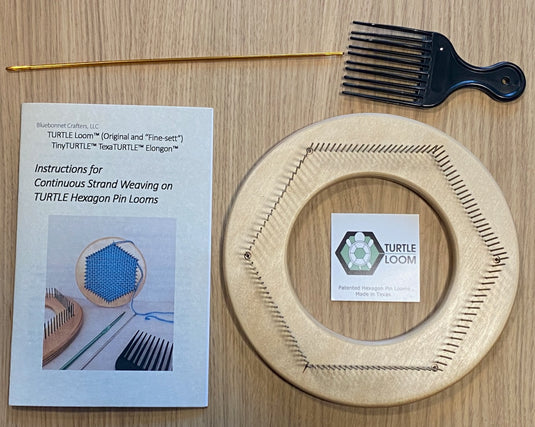
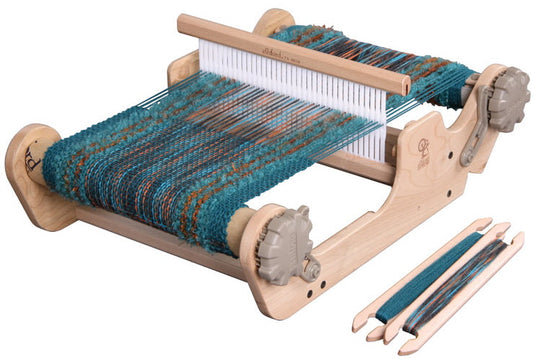
Rigid Heddle Looms
Suitable for Beginner to Intermediate Weavers
The Rigid Heddle Loom, such as the Schacht Cricket Loom and Ashford SampleIt, were the first looms that Ange at Weft Blown learned to weave on and she still uses it today and also teaches one day classes with them too.
The loom works by having a rigid heddle reed which the warp yarns (the yarn that goes onto the loom) are threaded alternately through a series of slots and eyes in the reed. This means when the heddle is in the up position the eye threads are up and in the down position the slot threads are up. When you then put the weft yarn through using a shuttle when the heddle is in the up position and then is moved to the down position once the shuttle has been passed through, the weft yarn then goes over and under alternating threads. This is faster than weaving on a Tapestry Loom.
It is very easy to warp using the Direct Warping Method and then you can weave away in either plain weave or using pick up sticks to create textural patterns. You can also weave with two heddles to create more complex pattern and even create a double width cloth.

Rigid Heddle looms are great for both beginner and more advanced weavers as they are quick and easy to set-up and also very portable so you can take them with you to local Guild meetings or on holiday with you too. As you are making cloth you can either weave a piece for a single project or sew, stitch or cut your cloth to make anything from blankets to your own wardrobe of clothes. For ideas for Rigid Heddle weaving check out these Rigid Heddle Weaving Books. We also have YouTube videos to help you warp up and weave that go along with our weaving kits.
These looms come in a range of sizes from 10" up to 48". The smaller sizes are good if you're wanting to weave scarves and smaller pieces. If you want to weave large pieces of cloth then a wider loom would be better but do be careful as anything above 25" in width can be cumbersome to weave on so we would recommend a stand for the loom to go on. 20-25" is a really good size to get and remember that you can weave from 8" wide up to the full width on the loom depending on your project. An excellent place to start is the Ashford SampleIt Complete Weaver Kit which comes with everything you need to get going including yarn, a Learn to Weave Booklet & Scarf Instructions and the Ashford Book of Rigid Heddle Weaving.
Inkle, Braid and Band Looms
Inkle, Braid and Band Looms are used to weave warp faced (only the warp threads can be seen) bands. They are straightforward to use and setup and can weave anything from simple to complex patterns.
Inkle looms have the warp wound on the loom in a circular loop so you are restricted to the length you can weave. However, they are small and easily fit onto a table top.
With the band loom you measure the warp in advance and place it onto the loom and you can use treadles to change which threads are lifted up or down. This can make it faster to weave on and you can weave longer lengths of bands on these looms than the inkle.
The bands can be used for making handles on bags, belts or other decorative objects.
You can also use Weaving Cards with or without an Inkle or Band Loom to create complex patterns too.
For ideas on patterns for Inkle Looms we recommend The Weaver's Inkle Pattern Directory by Anne Dixon.
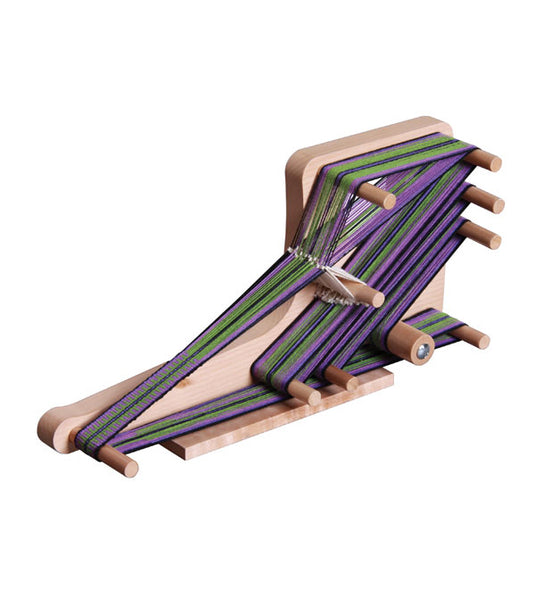
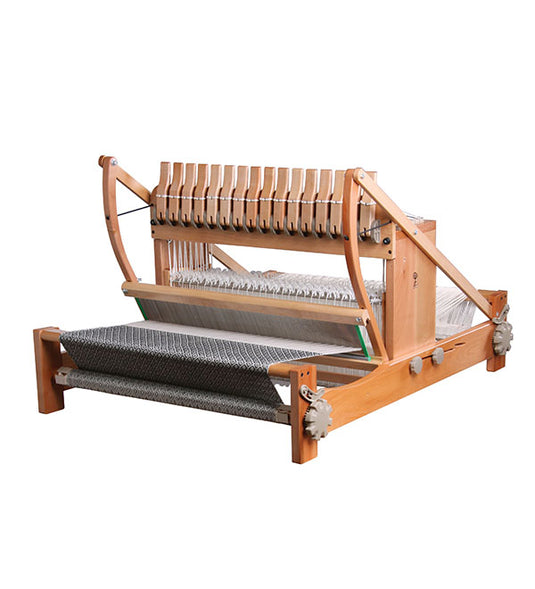
Table Looms
Suitable for Beginners to Advanced Weavers
Table Looms are great way to get into more complex pattern weaving in an accessible way. This is a good type of loom to step up to from rigid heddle weaving or even a great loom for beginners wanting to know the full ways of the world of weaving. These looms have a slightly more complex method of warping as you need to measure your warp using a warping board, warping mill or warp pegs. You then wind the warp onto the loom whilst having it spread on a raddle. Next you thread the warp yarns through the heddles on the shafts (the sections that move up and down) and then through the reed. Finally you tie it onto the front apron rod of the loom and you’re ready to weave. To weave you move the pegs on the front of the castle (upright part of the loom) to lift and lower the shafts.
The patterns you can create on these looms can be determined by how you thread up the loom and which shafts you move up and down.
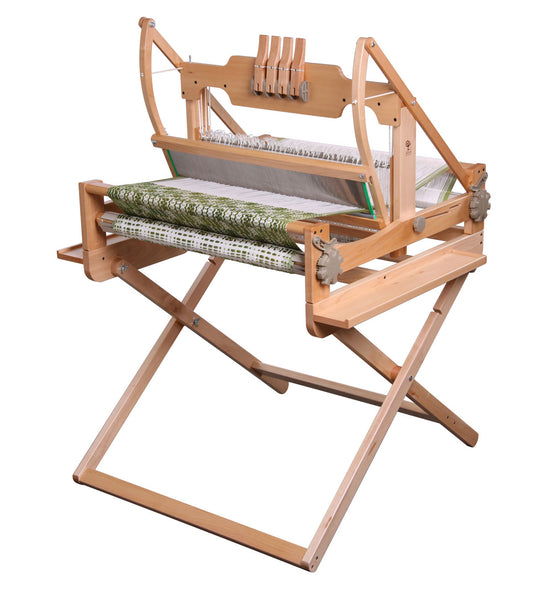
These are very versatile looms and you can change patterns very quickly by switching around which shafts you move.
8 shaft versions of table looms are a good choice to go for and you don’t have to use all the shafts as you can just thread up 4 shafts and leave the other 4 shafts empty.
Some table looms do fold up too so can be taken to workshops or meet-ups too.
You can get stands for the looms and second warp beams which would let you use different types of yarns for the same cloth.
We have a great range of books for table looms that help you to get weaving on them as well as giving you lots of pattern ideas.
A table loom is a really useful loom to have as you can experiment with weave patterns really easily and is great fun to weave on.
Floor Looms
Suitable for Beginner to Advanced Weavers
Floor looms, such as the Schacht Baby Wolf loom, come in a range of sizes with differing shaft numbers which can confuse a new weaver as to which to go for.
Floor looms differ from table looms in that instead of using levers on the front of the loom to move the shafts, treadles under the loom are tied up to the shafts so when you step on them the shaft moves up or down.
There are several different systems to do this ranging from Jack looms which directly pull the shafts down, to countermarche which moves shafts up and down to give a wide shed.
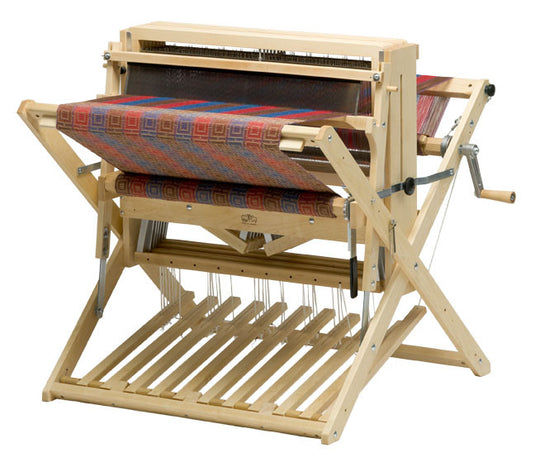
Jack looms like the Ashford Jack are the simplest to understand for beginner weavers as you just need to think about which shaft needs to move to create the pattern.
The Jack system on the looms we sell lift the pattern shafts so it's easy to see the pattern as you're weaving.
Due to this mechanism the tie up is simple as you only need to attach the jack to the shaft that is involved with the pattern shaft.
The floor looms we stock come in sizes from 18”/45cm to over 45”/1150cm in width. So it comes down to where you’re wanting to keep your loom. Obviously the wider the loom the wider the cloth you can weave but you also need to bear in mind that weaving over 1m can be tricky without something like a fly shuttle device as arms can only throw a shuttle at such a width.
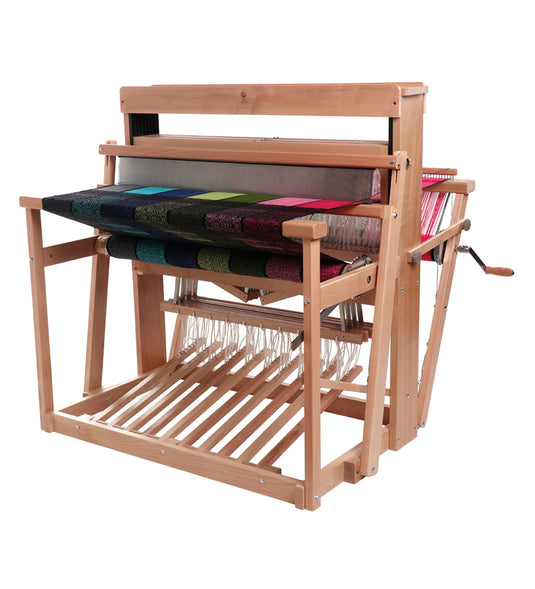
Smaller looms can easily fit into any room in the house and some like the Schacht Wolf Pup and Baby Wolf looms can be folded up and taken in the car to workshops or meetings.
The final consideration is the number of shafts that you want and what type of patterns you want to weave. The more shafts the more complex patterns you can do, but you can also do a huge range of patterns with just 4 shafts. The Schacht Baby and Mighty Wolf Looms can be bought as a 4 Now 4 Later set-up so you can change from a 4 shaft loom to an 8 shaft loom at a later date if money is an issue.
You can jump straight into getting a floor loom if you are a beginner weaver, but sometimes it is easier if you’ve used a rigid heddle or a table loom first as it makes it an easier learning curve.
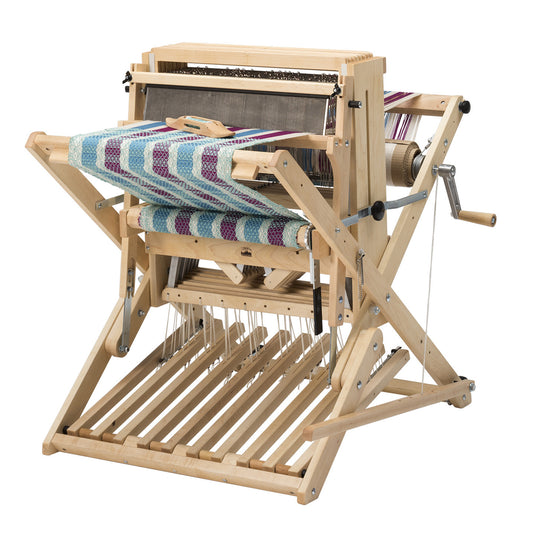
Weaving Accessories
Great for rigid heddle looms and on table and floor looms if you’re not weaving large widths.
These are useful for table and floor looms and can be used on rigid heddle looms too. Yarn unwinds from the pirn/bobbin on the shuttle and makes weaving easier. A bobbin winder is a really good accessory to make sure your yarn in wound properly onto your pirn/bobbin.
The yarn is tensioned on these bobbins and makes weaving straight edges easier.
These are useful to use with thick or textured yarn as well as fabric used for weaving rag rugs.
Rigid Heddle Looms and Table Looms can be used on a table or you can buy a stand made specifically for each loom. Stands can be useful as it positions the loom at a correct height for weaving on and makes it more ergonomic to sit at.
To measure the warp for table or floor looms you will need one of these warping devices. They work by winding the warp yarn around the pegs on the board or the mill and once wound and measure you chain it off ready to be wound onto your loom.
If you are wanting to use a mixed warp of different yarn types such as cotton and wool it can be easier to wind each yarn type onto separate warp beams so you can get even tension. Also works well for double weave warps too.
These are used on rigid heddle looms and when used with 2 heddles of the same sett (dpi) then you can create texture pattern cloth or create double weave cloth on your rigid heddle loom. Some looms come with a second heddle holder fitted so check this first before buying one,
The reeds on a rigid heddle have different sizes and are designed for different thicknesses of yarn. Generally a 2.5 dpi is for Chunky yarn, 5dpi reed is for Aran weight yarns, 8dpi for Double Knit, 10dpi for 3ply/Sportweight, 12.5dpi for 4ply and 15dpi for 5/2 cotton and lace weight.
For table and floor looms the sett of the fabric is defined by how you thread the warp yarns through the reed. Reeds come in different sizes and you can get them for thicker yarns using a 5dpi reed or up to 25dpi reed for fine yarns.
These are useful for winding bobbins and pirns that are used with boat shuttles
With a sectional warp beam and a tension regulator you can wind your warp in 1” sections onto your warp beam. This gives an even tensioned warp.
Contact Us
We hope that this guide has helped you decide what loom is best for you. However, if after reading this you’re still not sure or would just like some more information, then do please contact us as we’re always happy to help you find the right loom for you.
